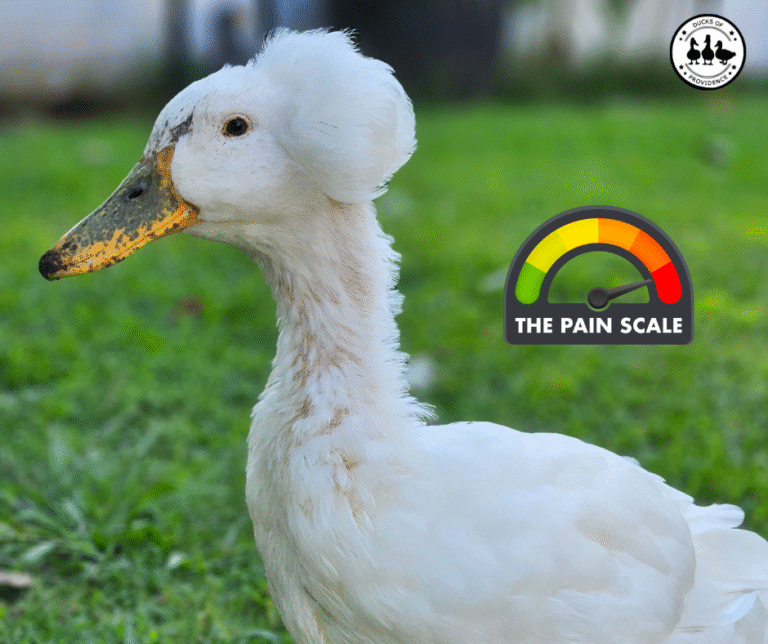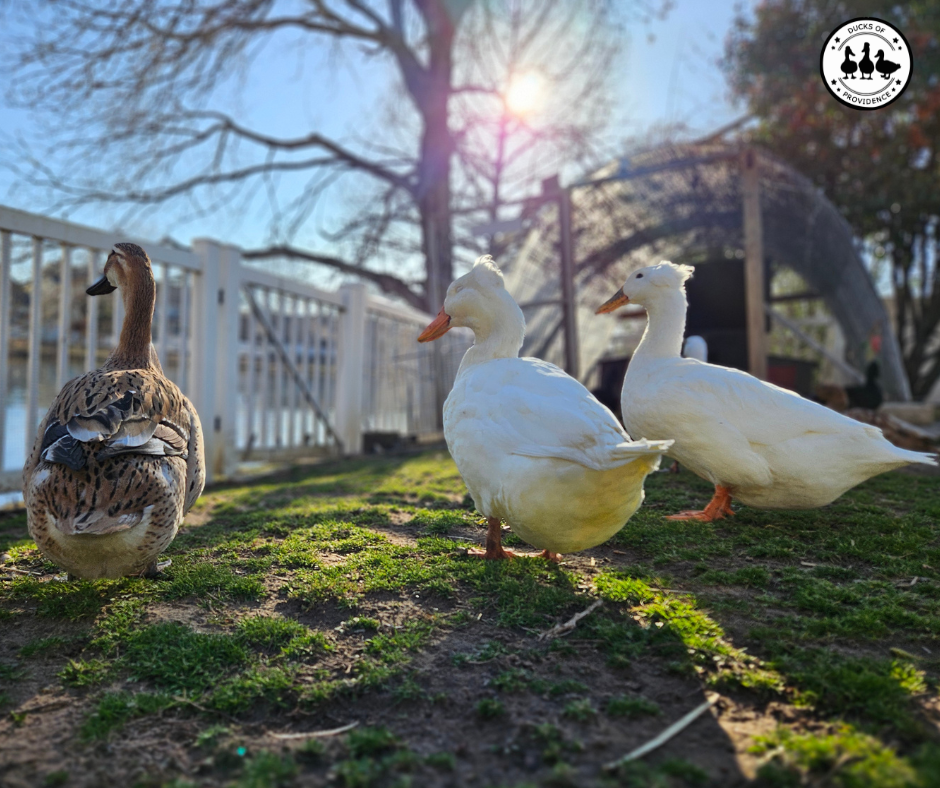
Creating the Perfect Home for Your Pet Ducks: Housing, Space, and Safety Tips
Ducks are more than just backyard animals—they’re intelligent, social, and full of personality. When kept as pets, they rely on us not just for food and affection but for a safe and enriching environment that meets their unique needs. Over the years, we’ve learned that proper housing isn’t just about building a structure—it’s about creating a space where ducks can express natural behaviors, stay healthy, and feel secure.
Unlike chickens, ducks don’t roost at night or climb, and they love water. They’re also surprisingly vulnerable to predators, even in suburban areas. These differences mean that their housing requirements are quite specific. From the design of the coop and run to the layout of feeders and water sources, every decision matters for their well-being.
In this guide, we’re diving into everything we’ve learned through both scientific research and years of hands-on experience with our own flock of seven pet ducks. We’ll walk you through what makes a good duck coop, how much space ducks actually need, what to watch for when free-ranging, and how to turn your duck run into a safe and stimulating haven. Whether you’re just starting out or looking to upgrade your current setup, this post will help you create a space your ducks will love—and thrive in.
Ducks of Providence is free, thanks to reader support! Ads and affiliate links help us cover costs—if you shop through our links, we may earn a small commission at no extra cost to you. Thanks for helping keep our content free and our ducks happy! 🦆 Learn more
Duck Housing Basics: Coop, Run, and Aviary
Before we dive into the finer details of bedding, enrichment, and space, it’s important to understand the foundation of duck housing: the coop, the run, and, in some cases, the aviary. These three elements form the core of your ducks’ living environment, especially if they aren’t free-ranging full time.
Each of these structures plays a different role in keeping your ducks safe, comfortable, and healthy. A well-designed coop gives them a secure place to sleep and lay eggs, while the run provides space for daytime activity, foraging, and socializing. In higher-risk areas, a fully enclosed aviary can be a game-changer, offering the benefits of outdoor living with added protection from predators.
Let’s take a closer look at what each part of your ducks’ home should include, how much space is ideal, and what features can help keep your flock happy and secure.
The Duck Coop
The coop is your ducks’ nighttime sanctuary—a place where they can rest, feel secure, and stay protected from predators and the elements. Unlike chickens, ducks don’t roost, so their housing needs are a little different. They prefer to sleep nestled on the ground, which means your duck coop should be low to the ground, easy to clean, and predator-proof from all sides, including underneath.
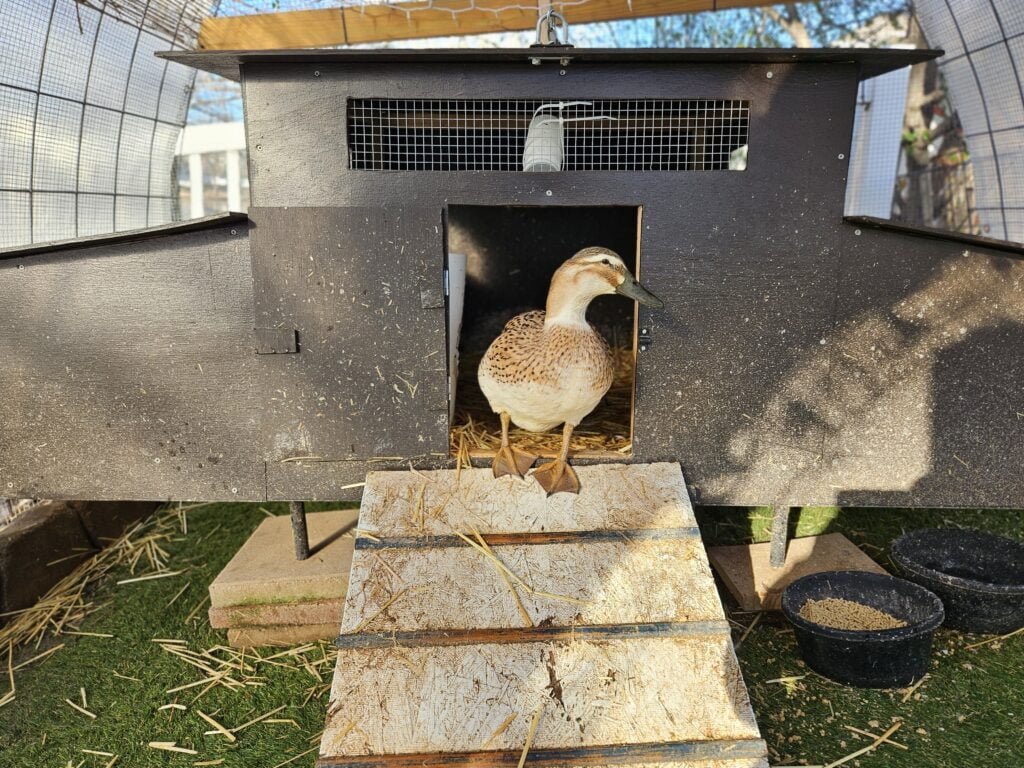
Key Features of a Good Duck Coop:
- Size and Space:
Ducks need room to lie down, stretch their wings, and move around without stepping all over each other. A good rule of thumb is 4 to 6 square feet per duck inside the coop. Bigger breeds like Pekins may need even more space. - Ventilation Without Drafts:
Ducks produce a lot of moisture as they breathe and poop overnight. Without proper airflow, ammonia builds up fast and can lead to respiratory issues. Place vents high up near the roof to keep air moving while avoiding chilly drafts at duck level. - No Perches Needed:
Ducks sleep on the ground, so you don’t need roosting bars. Instead, provide clean, dry bedding like pine shavings or straw, and make sure the floor is moisture-resistant. We use vinyl over plywood for easier cleaning and extra protection from spills and droppings. - Predator-Proof Design:
The coop should be built from solid wood or heavy-duty materials—not chicken wire—and have lockable latches. We recommend using ½-inch hardware cloth on any openings and ensuring the floor is either solid or reinforced with buried wire mesh to prevent digging predators like raccoons, opossums, or rats. - Accessible Nesting Areas (for egg-laying hens):
While not every duck will use them, some of our girls love their nest boxes. Place these in a darker corner with soft bedding. Make the roof above them hinge open if you want easier access for egg collection, like we do in our coop design. - Ease of Cleaning:
Ducks are messy. Plan for a setup that lets you clean quickly and efficiently. Removable bedding, vinyl flooring, and hinged roofs or large doors make a big difference. We clean out our coop fully at least once a week, with spot cleaning in between. - Access Ramp or Low Entrance:
Because ducks are ground dwellers with flat feet, they appreciate a gentle ramp if the coop is raised. Keep the incline shallow, with traction strips or rubber mats for grip. Our setup includes a ramp with traction strips.
The Duck Run
While the coop is for sleeping and laying eggs, the run is your ducks’ daytime playground. It’s where they’ll spend most of their waking hours—eating, exploring, socializing, preening, and napping in the sun. A well-designed duck run gives them room to stretch, splash, and forage while keeping them safe from predators and environmental hazards.

Why a Run Is Essential
Even if you free-range your ducks part of the time, a secure run is crucial. It gives them a protected space when you’re not around to supervise and is especially important during flockdown restrictions, poor weather, or predator activity in your area. Ducks love to roam, but they’re also vulnerable, so having a reliable run setup can literally be a lifesaver.
Ideal Duck Run Size
- Minimum recommendation:
At least 10 to 25 square feet per duck, depending on the breed and how often they get time outside the run. More is always better. - Larger breeds, like Pekins or Silver Appleyards, benefit from extra space due to their size and lower agility.
- Smaller or more active breeds, like Indian Runners or Calls, also appreciate room to explore.
We’ve found that giving our ducks plenty of space cuts down on boredom, bullying, and mess buildup—and it’s a joy to watch them waddle, bathe, and forage freely.
Predator Protection
Ducks are sitting targets for a wide range of predators, so safety should always be top priority when building a run:
- Use ½-inch hardware cloth (not chicken wire) on all sides, including the bottom 1–2 feet of the fence.
- Bury the fencing 12–18 inches deep, or create an apron of hardware cloth around the outside to prevent digging.
- Cover the top with netting, hardware cloth, or a solid roof to keep out hawks, owls, raccoons, and climbing predators.
- Secure the entrance with a lockable latch—raccoons are clever and can open basic latches if they’re determined.
We added motion lights and trail cameras near our run, which has helped us identify visiting wildlife and prevent nighttime surprises.
Flooring Considerations
- Bare ground quickly turns into mud, especially with water-loving ducks.
- We initially used pea gravel, which kept the run clean but proved too rough and led to bumblefoot.
- On our vet’s advice, we switched to premium pet-friendly artificial turf with drainage holes. It’s soft, easy to hose off, and has worked beautifully for over two years.
- Other great options include grass (if it holds up), sand, or a combination of mulch and pavers. Avoid sharp stones or slippery surfaces.

Enrichment Inside the Run
Ducks need mental stimulation, especially in confined spaces. Consider adding:
- Kiddie pools or shallow tubs for water access
- Foraging zones with edible plants (like duck-safe greens)
- Logs, stumps, or shaded platforms for resting
- Frozen treats or food puzzles for hot days
We rotate a few items every week to keep things interesting. It’s amazing how excited our ducks get about a new log or bucket of fresh greens.
Weather Protection
- Provide shade using tarps, pergolas, or shrubs. Ducks are surprisingly heat-sensitive.
- Install windbreaks in winter using clear plastic sheeting or straw bales.
- Make sure there’s always a dry, sheltered spot where ducks can rest comfortably away from the wind or rain.
The Aviary Option: Full Protection, Full Freedom
An aviary is a fully enclosed outdoor structure that offers ducks safe access to fresh air, sunlight, and enrichment—all while keeping predators out. Unlike a standard run, an aviary is protected on all sides: roof, walls, and often the floor as well. For many pet duck owners, especially those in predator-heavy areas or with smaller breeds, an aviary becomes the primary living space for their flock.
How It Differs from a Traditional Run
| Feature | Run | Aviary |
|---|---|---|
| Top Cover | Often netting or tarp | Fully enclosed with hardware cloth or roof panels |
| Bottom Protection | Optional (buried fencing or apron) | Often enclosed or solid floor layered with bedding/turf |
| Predator Safety | Moderate (depends on build) | High—fully protected from aerial, digging, and climbing threats |
| Function | Daytime use, needs separate coop | Can serve as both daytime and primary living space |
| Space Needs | 10–25 sq ft per duck (minimum) | Often significantly larger, since ducks spend most or all of their time inside |
| Cost and Effort | Lower | Higher—more materials, but greater peace of mind |
Why Aviaries Often Require More Space
Because the aviary becomes your ducks’ main residence, many duck keepers choose to build them larger than a typical run. This gives the ducks enough room to:
- Swim in a real pond or a large in-ground tub
- Forage naturally in planted areas or among logs and grass
- Exercise without feeling confined
- Stay stimulated with a variety of enrichment options
If you keep bantam or light-bodied breeds, such as Call Ducks or Mallards, you may notice that they’re capable of flight, especially if their wings aren’t clipped. In such cases, a taller aviary provides not only protection but also space to fly short distances and move more naturally. Watching them take a short flight across the enclosure adds another level of joy for both you and your ducks.
The larger space also helps reduce mess and gives your ducks a more natural lifestyle, especially important if they aren’t free-ranging.
Coop or No Coop?
Most aviaries still include an attached coop or night shelter, and ducks are often encouraged to sleep inside it:
- In colder climates, it helps block wind and retains warmth.
- Some duck keepers prefer ducks sleeping in a coop for better predator protection overnight—even in a fully enclosed aviary.
- During warmer months, some flocks may choose to sleep directly in the aviary, especially if it offers a quiet, covered corner with soft bedding.
Ultimately, whether or not your ducks use the coop depends on your setup, climate, and flock preferences. Offering the option—an open coop inside or adjacent to the aviary—gives both ducks and humans the most flexibility.
Design Tips
- Make the aviary tall enough (5–6 ft minimum) for easy cleaning and entry.
- Use ½-inch hardware cloth on all sides for maximum safety.
- Include shaded areas, windbreaks, and waterproof sections.
- If building a pond inside, ensure proper drainage and include pavers for dry resting zones.
- Use a combination of natural ground cover, soft bedding, and artificial turf to reduce mud and provide traction.
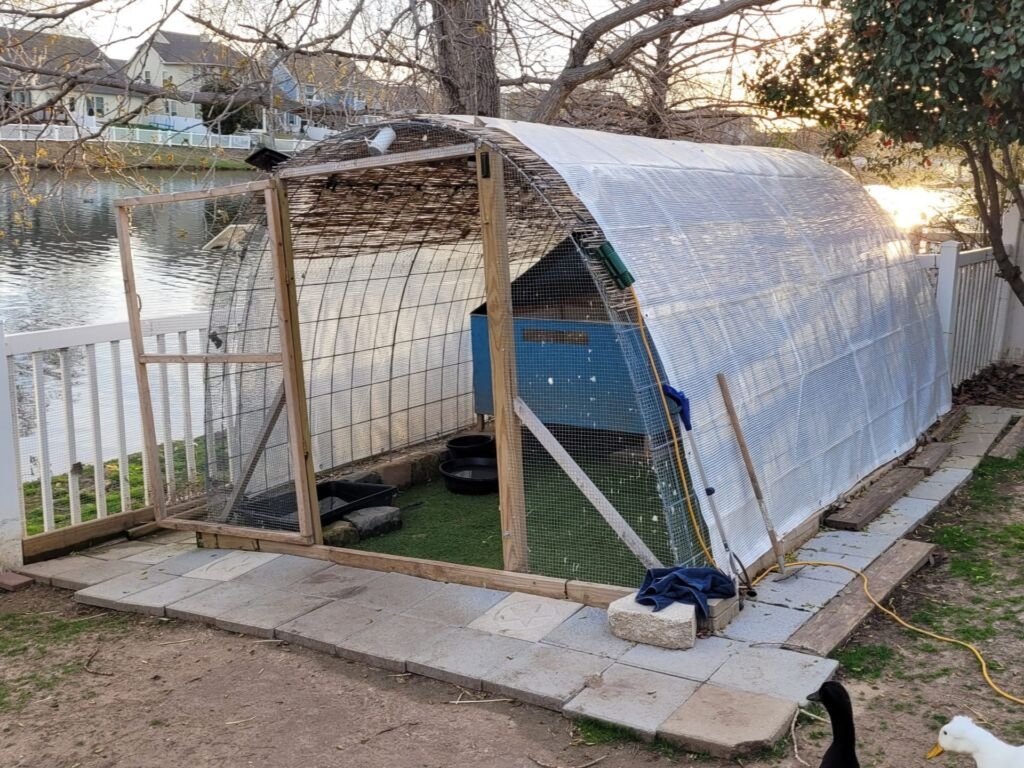
Free-Ranging Ducks: Pros and Cons
Free-ranging is a popular and often romanticized part of backyard duck keeping—and for good reason. Watching ducks explore the yard, nibble at weeds, chase insects, and splash in puddles feels wonderfully natural. It allows them to express many of their instincts and can lead to healthier, more content birds.
But free-ranging isn’t always the best—or safest—option, especially for pet ducks. There are important risks and responsibilities that every duck keeper should weigh carefully. In fact, we’ve written a dedicated post that goes in-depth on how to free-range ducks safely, what supervision they require, and how to protect them in different environments. (Check out our full guide here!)
Here’s a quick look at the main advantages and disadvantages:
Benefits of Free-Ranging
- Natural foraging: Ducks love to nibble on grass, clover, bugs, and even small worms. Free-ranging helps diversify their diet and keeps them mentally engaged.
- Exercise and enrichment: A larger space gives ducks room to waddle, stretch, bathe in mud, or take short flights if they’re light-bodied.
- Cleaner housing: Less time in the run or coop can mean less mess to manage, though you may trade that for droppings in other areas!
- Less feed consumption: Ducks supplement their diet with natural forage, which can slightly reduce feed costs (though we still recommend a complete feed as their main diet).
- Social interaction: Ducks get curious and sometimes even follow us around the yard, especially when we’re gardening.

Risks and Considerations
- Predators: Free-ranging increases exposure to hawks, foxes, raccoons, neighborhood dogs, and even snakes. We’ve known people who lost ducks in minutes, even in suburban areas.
- Wandering: Ducks can cover more ground than you’d think, especially curious breeds. Without fencing or supervision, they may wander off, get stuck in tight places, or approach roads.
- Toxic plants and hazards: Not every backyard is duck-safe. Certain plants, pesticides, fertilizers, or even small objects (like screws or coins) can pose serious health risks.
- Seasonal dangers: During avian influenza outbreaks, flockdown restrictions often prohibit any outdoor access that isn’t under a covered enclosure. Free-ranging is not permitted during these times.
- Egg hiding: If you have laying hens, free-ranging may mean playing a daily game of “Where’s the nest?” Ducks are sneaky when it comes to hiding eggs!
Our Advice?
We love giving our ducks time in the yard—but only under supervision and only when it’s safe. We use a fenced section of our property to limit their access and always check for predators before letting them out. During certain times of year, such as peak hawk season or flockdown advisories, they stay in their secure run and aviary. It’s all about balance.
If you’re considering free-ranging, we highly recommend reading our in-depth post on this topic to help you make an informed, safe decision for your flock. Your ducks’ health and safety always come first.
Space Requirements
One of the most common questions new duck parents ask is, “How much space do my ducks need?” The answer depends on a few factors—like the breed, whether your ducks free-range, and how much time they’ll spend inside their housing versus outside in a run or aviary.
Unlike chickens, ducks are not climbers or perchers. They live life at ground level, which means floor space matters most. Giving your ducks enough room to move, forage, and socialize helps reduce mess, aggression, and stress—and ultimately leads to healthier, happier birds.

Minimum Space Guidelines
These are general recommendations based on common pet breeds. More space is always better when possible!
| Area Type | Minimum Space per Duck | Notes |
|---|---|---|
| Coop (indoors) | 4–6 sq ft | Only for sleeping and laying. No perches needed. |
| Run | 10–25 sq ft | For daytime use. Adjust based on breed size/activity. |
| Aviary | 20+ sq ft | Should be more spacious, since it’s their primary space. |
| Free-range Yard | Variable (fenced or supervised) | Supplemental only—never a substitute for secure housing. |
Adjusting for Breed Size and Behavior
- Larger breeds, like Pekins, Silver Appleyards, or Jumbo Saxonies, require more space to accommodate their size and mobility.
- Active or flighty breeds, like Indian Runners or bantams, benefit from longer, more open runs to explore and move naturally.
- Small, flight-capable breeds, like Call Ducks, enjoy vertical space as well. In an aviary, a taller structure lets them flutter and engage in short flights, adding both exercise and enrichment.
We’ve noticed firsthand how more space reduces squabbles and encourages natural behaviors like preening, bathing, and napping in the sun. Ducks with ample room are also cleaner—their droppings are less concentrated, and their bedding stays fresher longer.
Multi-Purpose Space Planning
If your space is limited, consider rotating access between different zones (like an attached run, a seasonal yard area, and a water station) or using movable fencing to shift the outdoor space and allow areas to recover.
We’ve also seen success with modular setups—attaching the coop to a partially covered run, which connects to a larger, predator-secure aviary. It gives the ducks flexibility and allows us to adapt as the seasons or our routines change.
Predator-Proofing Must-Haves
Predators are one of the biggest threats to pet ducks, and unfortunately, they’re more common than many new duck keepers realize. Whether you live in the countryside, suburbs, or even in a city, chances are you have predators nearby that would love a duck dinner. Raccoons, foxes, hawks, coyotes, snakes, and even dogs or cats can all pose serious danger.
Ducks are especially vulnerable at night and don’t naturally seek high roosts or hidden nesting spots the way some birds do. That means it’s up to us to make sure their housing is secure, every single day and night.
Here’s how to predator-proof your coop, run, or aviary with confidence:
Use the Right Materials
- Hardware cloth is non-negotiable.
Use ½-inch hardware cloth (not chicken wire) on all openings, windows, and vents. Chicken wire keeps ducks in, but won’t keep predators out—it’s easily chewed or torn. - Solid wood or heavy-gauge metal for framing.
Avoid flimsy lumber or plastic panels that raccoons can pry open. - Screws, not staples.
Predators can pull out staples over time. Use screws and washers to firmly attach hardware cloth to frames.
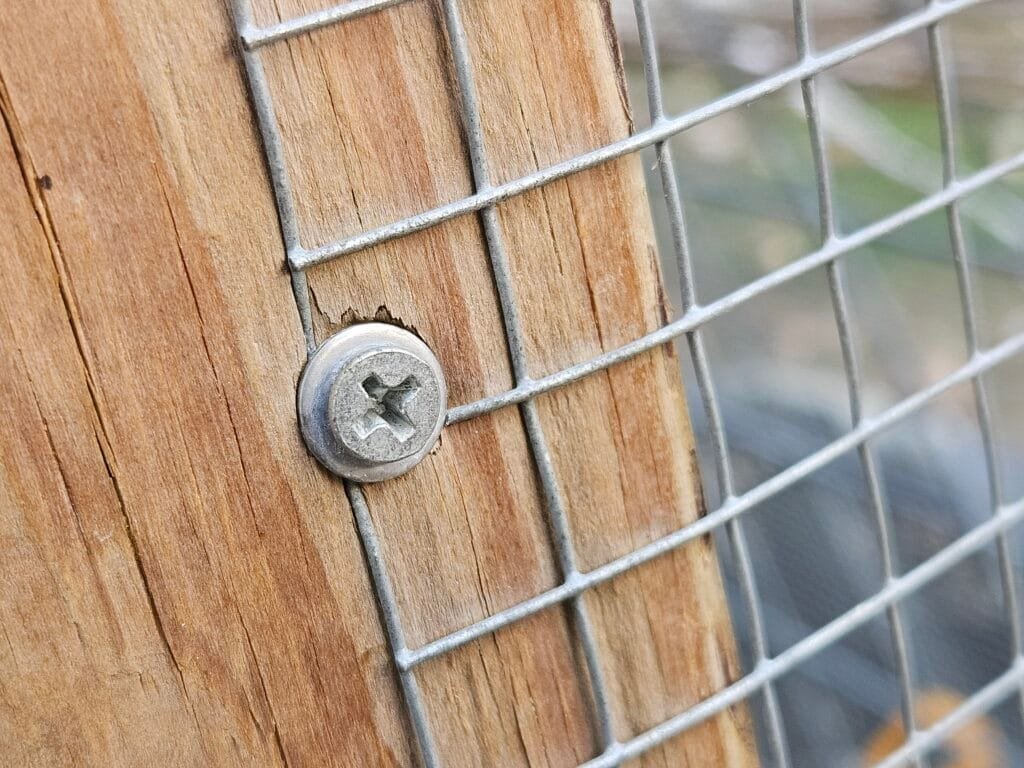
Secure the Entrances
- Use predator-proof latches.
Raccoons can open simple slide latches or knobs. Choose double-locking latches or carabiners. - Automatic door closers help.
If you’re not always home at sunset, an automatic door can close the coop safely at dusk and open it again in the morning. - Lockable gates on runs and aviaries.
Make sure humans can access the enclosure easily for cleaning and feeding—but only humans.
Don’t Forget Below and Above
- Bury fencing 12–18 inches underground, or create an outward-facing hardware cloth apron around the base of the coop and run to stop digging predators like foxes, rats, and skunks.
- Cover the top of the run or aviary.
Use hardware cloth, welded wire, or a solid roof to keep out hawks, owls, and climbing animals like raccoons and opossums. - Secure the floor if needed.
Some keepers add a buried wire mesh floor or build their coop on a concrete slab to keep rats, snakes, or mink from tunneling in.
Behavior-Based Safety
- Never leave food or treats out overnight.
This attracts rodents, raccoons, and even bears in some areas. We use an automatic feeder that closes at night. - Store feed in metal bins.
Plastic containers can be chewed through, especially by rats or squirrels. - Clean up water spills and uneaten feed daily.
Standing water and feed scraps are magnets for unwanted visitors.
Monitoring and Upgrades
- Install motion sensor lights or cameras.
We use these to monitor wildlife activity near our run. Knowing what’s lurking around helps us adapt our setup as needed. - Regularly inspect your setup.
Look for signs of digging, chew marks, or weak spots. Address damage right away—predators are persistent and remember where they find easy meals.
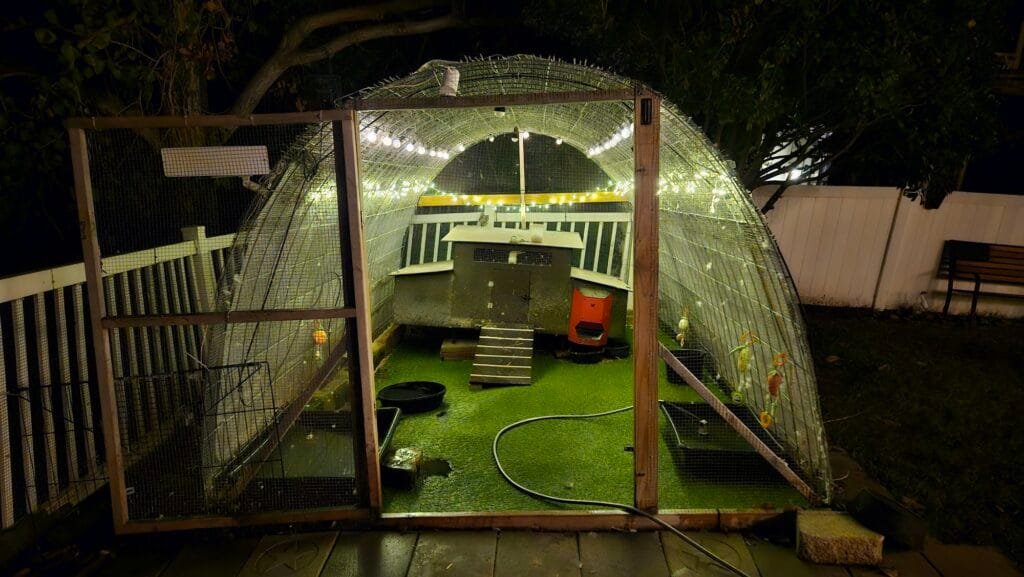
A predator-proof setup isn’t just about fencing—it’s about planning for persistence. Wild animals are clever, especially when they’re hungry. But with the right design and materials, you can sleep soundly knowing your ducks are safe.
Tips to Enrich the Duck Run
Ducks are curious, active creatures that thrive on mental stimulation and opportunities to express natural behaviors. While a safe coop and run provide the foundation for good housing, enrichment is what turns that space into a true home. A well-enriched run helps prevent boredom, reduces aggression, and supports physical and emotional well-being.
Over the years, we’ve tested a variety of enrichment ideas with our own flock—and the results are always worth it. Happy ducks are more engaged, healthier, and more fun to be around!
Add Natural Features
- Logs and stumps: Perfect for climbing, preening, or resting. They add variety to the landscape and give ducks places to explore.
- Branches or brush piles: Create hiding spots and foraging zones, especially appreciated by shy or lower-ranking ducks.
- Bales of straw or hay: Great for pecking, climbing, and hiding insects to search for.
We love rotating these items every few weeks to keep things fresh and interesting.
Safe Plants and Foraging Zones
- Plant duck-safe greens like kale, Swiss chard, or nasturtiums in or near the run.
- Use hanging baskets or planter boxes just outside fencing to offer treats they can nibble but not trample.
- Scatter treats like chopped lettuce, peas, or dried grubs into the grass or bedding for natural foraging.
We sometimes toss fresh herbs or edible flowers into the run—our ducks especially love basil and parsley.
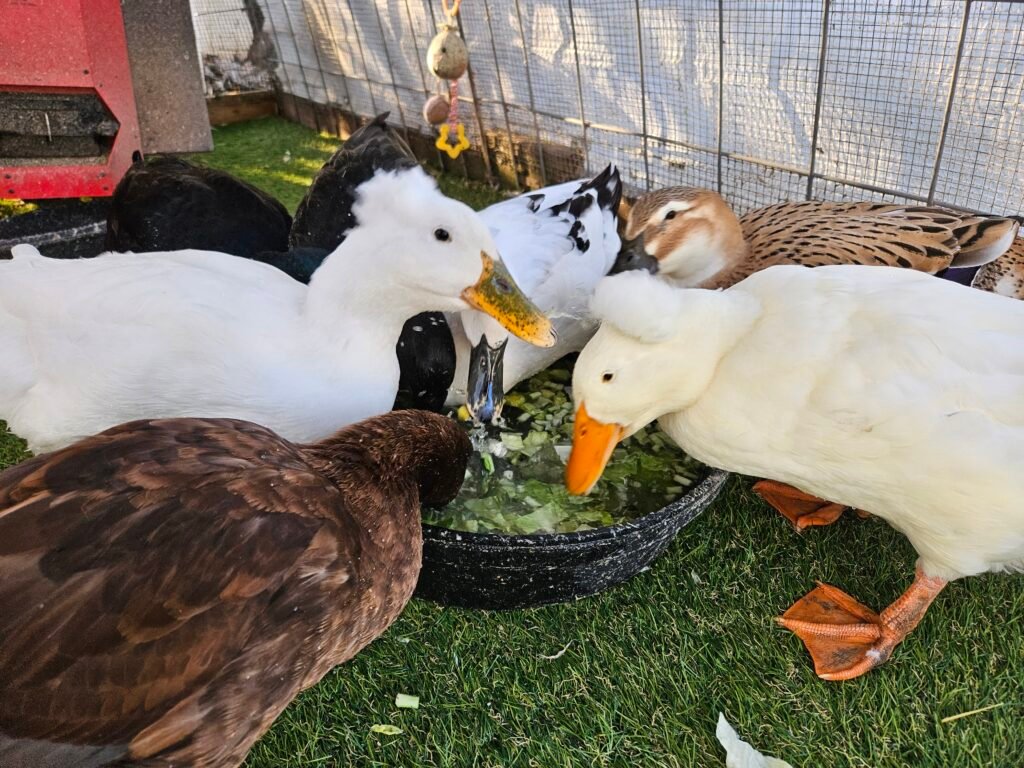
Creative Water Play
- Rotate different water tubs or kiddie pools for splash time.
- Freeze peas or chopped greens in ice blocks during hot weather to keep them cool and entertained.
- Add floating toys, like balls or plastic rings, for them to nudge around.
We often put a rubber duck in the pool just for fun—it’s silly, but our flock interacts with it!
Sensory Enrichment
- Hang CDs or mirrors outside the fencing—ducks are naturally curious about reflections and shiny objects.
- Use hanging baby toys that they can nibble on and play with.
- Place textured surfaces like smooth stones, turf patches, or sand pits for variety underfoot.
Interactive Food Enrichment
- Use a grub dispenser or toss treats into a pile of straw or leaves to encourage foraging.
- Offer food puzzles—like a container with holes that slowly releases dried treats as it’s nudged.
- Create seasonal foraging trays (e.g., pumpkin guts in fall, watermelon cubes in summer).
Ducks may not be as toy-motivated as dogs, but they absolutely respond to changes in environment and feeding patterns.
Resting Zones and Privacy
- Provide hideouts or shaded corners where ducks can relax undisturbed.
- Various levels or surfaces with platforms, pavers, or turf-covered mounds.
- Install a low-roofed shelter or small “gazebo” inside the run for weather breaks.
Even confident ducks benefit from a space to retreat and unwind, especially during flock squabbles or hot days.
Pro Tip: Ducks get used to routines quickly, so try switching up their environment regularly. We aim to add or rotate one new feature every week or two. It doesn’t have to be fancy—even a new log, treat spot, or splash bowl can make their day!
Water Sources: Essential for Duck Health
If there’s one thing ducks can’t live without—besides companionship—it’s water. Ducks aren’t just waterfowl in name; they rely on water for nearly every aspect of their well-being. From drinking and dabbling to preening and bathing, clean water is essential to both their physical health and mental happiness.
Whether you’re using a small tub, a kiddie pool, or a built-in pond, what matters most is consistency, cleanliness, and accessibility.
Why Ducks Need Water
- To Eat Properly: Ducks need water to swallow their food safely. Without it, they can choke or suffer from impacted crops.
- To Stay Clean: Bathing keeps their feathers in good condition, helps maintain waterproofing, and prevents problems like wet feather or lice.
- To Support Preening: Ducks preen after every bath, spreading oils from their uropygial gland to keep feathers healthy and water-resistant.
- To Cool Off: Especially in warm climates, access to cool water helps regulate body temperature and prevents heat stress.
We’ve seen how our ducks perk up after a good splash—and how it improves their mood, feather quality, and even their social interactions.
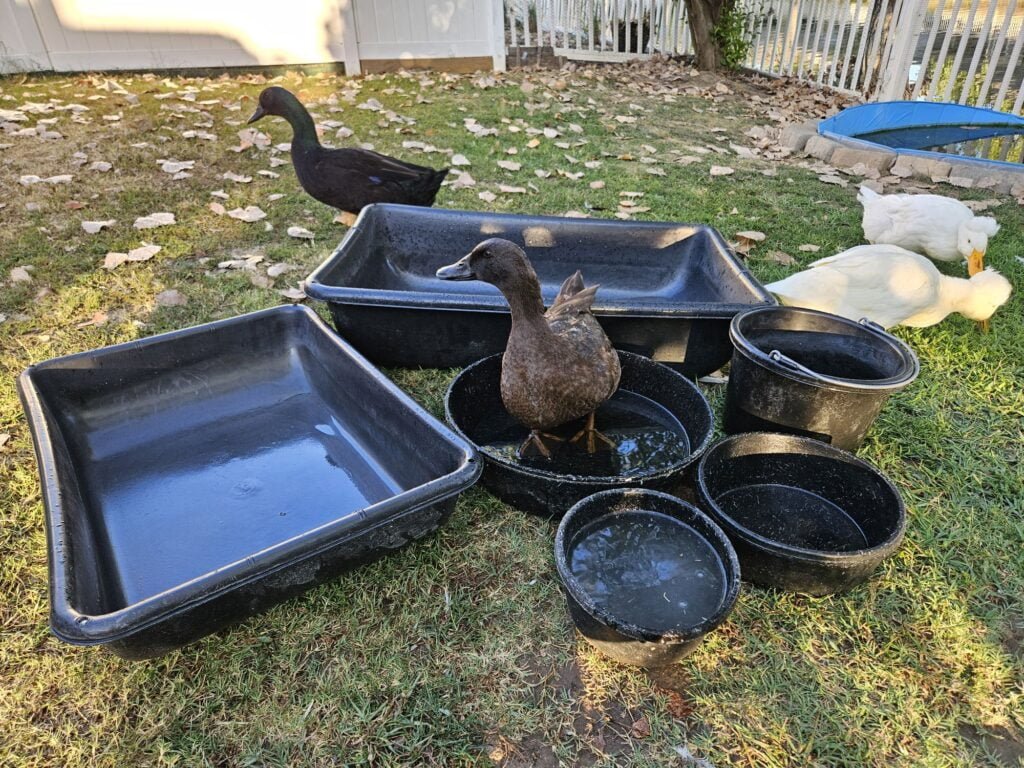
What Kind of Water Sources Work?
- Kiddie pools: Inexpensive and easy to clean. We use a large 12-inch-deep pet pool with a drain, which makes weekly cleanouts much simpler.
- Tubs or troughs: Heavy-duty rubber livestock bowls or plastic storage bins can also work well, especially in smaller spaces.
- Natural ponds: Lovely, but harder to clean and must be predator-safe. Always provide a safe, shallow exit area.
We added landscape pavers around our pools to help our ducks climb in and out more easily without tracking mud into the water.
Cleaning and Maintenance
- Change water at least every few days, or more often if it gets muddy or soiled.
- Scrub out biofilm or algae weekly to avoid bacteria buildup.
- Use shade and proper drainage to prevent the area around water stations from turning into a muddy mess.
Our schedule includes a weekly deep cleaning of the pig pool and daily cleaning of the smaller tubs. A nearby hose setup and good drainage are lifesavers.
Bathing vs. Drinking Water
It’s a good idea to separate water for drinking and bathing:
- Drinking water should be in a clean, shallow bowl—deep enough for ducks to dunk their entire head (which helps clear their nostrils and eyes).
- Bathing water can be larger and deeper, but should still have safe entry and exit points.
We often place drinking bowls or small buckets under a shaded area and refresh them multiple times a day in summer.
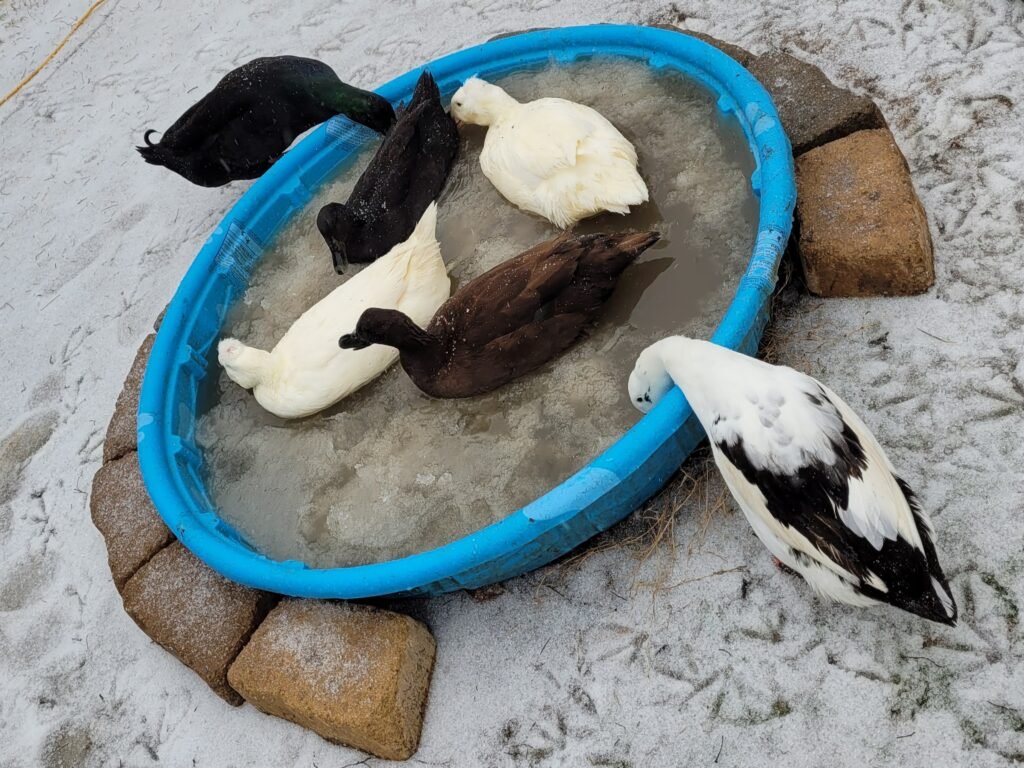
Winter Tips
- Use heated water bowls or refresh drinking water several times a day to prevent freezing.
- If your bathing water freezes over, skip the full baths and offer lukewarm water in a shallow tub for supervised splashing.
In our North Texas winters, we use black rubber tubs that absorb heat and keep water ice-free longer, plus a few warm water top-ups during colder spells.
➡️ Ducks and Water: Keeping Your Flock Happy and Healthy
Feeding Stations and Placement
Feeding ducks isn’t just about what you serve; it’s also about where and how you serve it. Proper feeder placement helps keep food clean, prevents waste, discourages rodents, and supports good hygiene and duck behavior. Over time, we’ve refined our own setup to meet the unique needs of a pet duck flock, and we’ve learned that a little planning goes a long way.
Basic Feeding Needs
- Ducks should have daily access to a complete waterfowl or all-flock feed.
- Feed should be available in a way that keeps it dry, clean, and easily accessible.
- Always provide clean water next to the feed, as ducks must wash food down to swallow safely.
We currently rotate between a few high-quality feeds (Grubbly Farms, Mazuri, and Purina) to meet the needs and preferences of our flock—some of our ducks are quite picky!
Where to Place Feeders
- Under a covered area: Protect feed from rain and sun to avoid spoilage and soggy messes.
- Next to water (but not in it): Ducks need to drink while eating, as they wash their food down to swallow safely. We place water dishes close to the feeder to support this behavior. One exception is floating feeds like Mazuri, which are designed to be fed in water. Serving feed this way mimics natural dabbling, helps reduce the risk of choking, and keeps the feeding area cleaner overall.
- Away from bedding: Placing feed near nesting or sleeping areas can attract pests and cause contamination. Keep feeding zones separate from where ducks sleep.
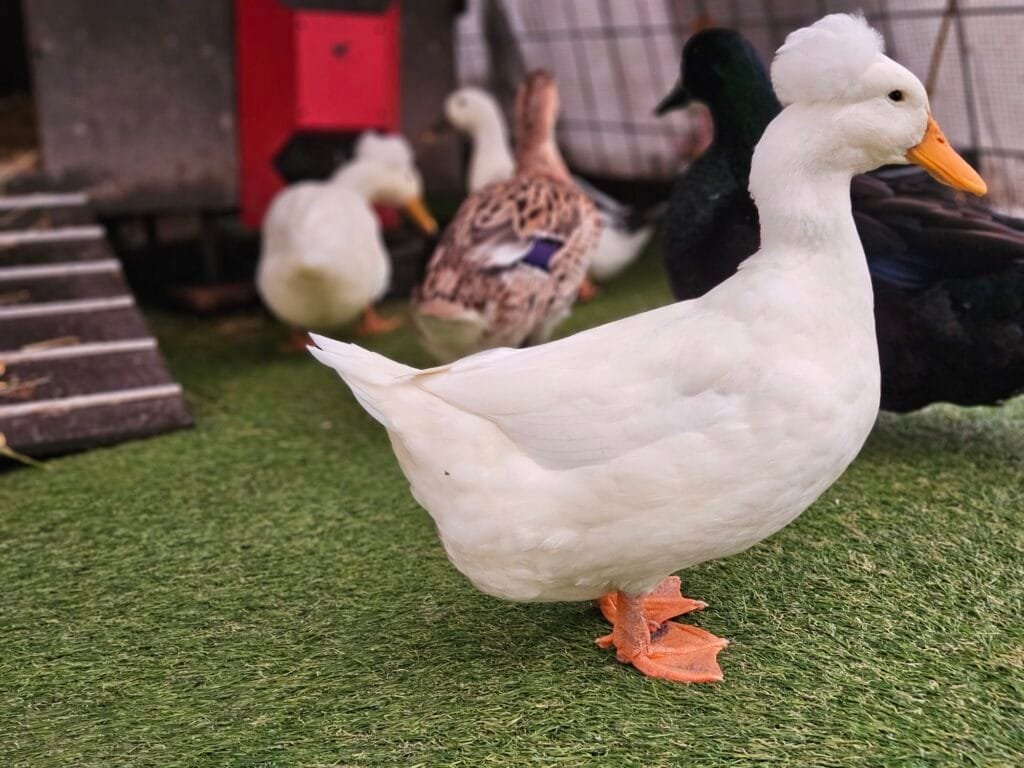
Rodent Prevention
- Use hanging feeders or elevated platforms to make access harder for rats and mice.
- Avoid free-feeding overnight. We use an automatic feeder that closes at dusk to keep rodents out.
- Store feed in metal containers with tight-fitting lids to prevent chewing.
After dealing with rodent damage (including a chewed-through solar panel cable and artificial turf), we switched to feeding systems that prioritize pest resistance and ease of cleanup.
➡️ Rodent Control in the Duck Run: Safe and Effective Strategies for Duck Keepers
Cleanliness and Safety
- Clean feeders regularly—wet or moldy feed can make ducks sick.
- Check for buildup or spillage daily, especially during rainy weather.
- If your ducks spill or trample feed, consider deeper bowls, heavier troughs, or no-tip feeders.
Some keepers also scatter feed directly onto clean grass or turf for foraging enrichment, but we only do this with treats, not their main diet.
Bonus Tips
- If you have a mixed flock with chickens or other birds, use species-appropriate feeders to prevent bullying or waste.
- In colder months, make sure feed stations are easy to access and not exposed to icy winds or frozen ground.
- For indoor ducks, use a non-slip mat or tray under the feeder to contain mess and protect the flooring.
Shade and Weather Protection
Ducks are surprisingly sensitive to extreme temperatures, especially heat. Unlike some other backyard animals, they can’t pant efficiently or sweat, and their thick feather coats can quickly lead to overheating. At the same time, cold winds, heavy rain, and snow can take a toll on their comfort and health if they’re not given adequate shelter.
Providing the right shade and weather protection in your duck run or aviary is essential year-round. It doesn’t have to be fancy, but it does need to be effective.
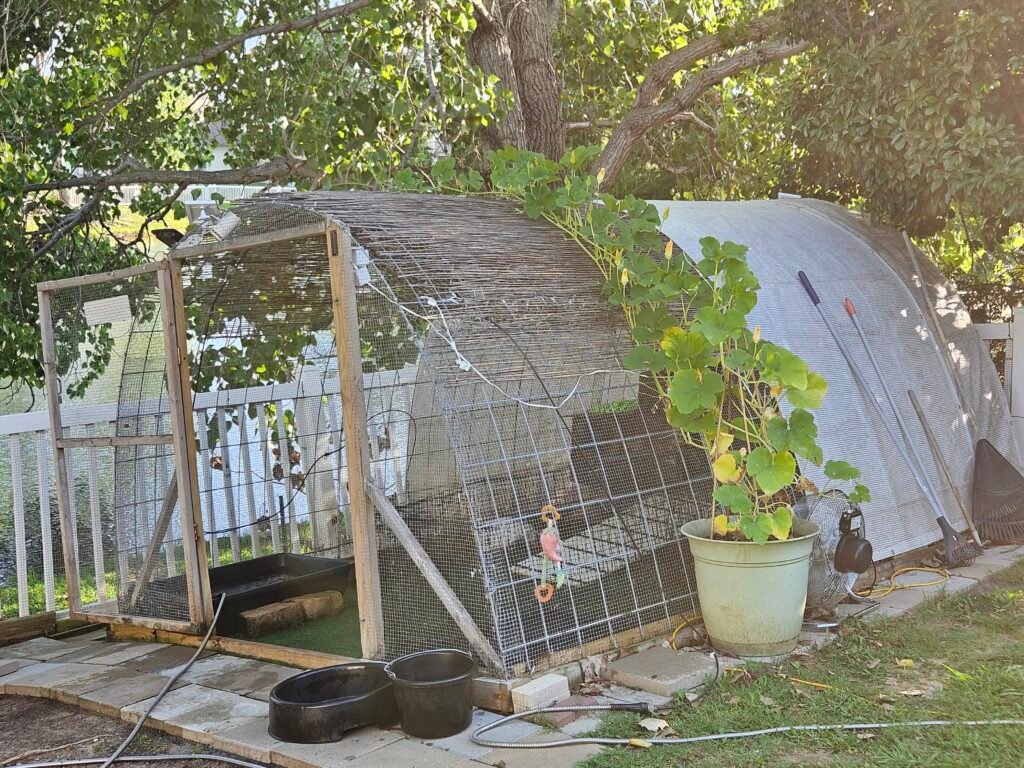
Summer Shade Essentials
- Ducks can overheat quickly, especially in hot, sunny climates. Shade is a must—not just a nice-to-have.
- Use tarps, sun sails, or pergolas to block midday sun. Secure them tightly to avoid flapping that could startle your ducks.
- Natural shade from bushes, trees, or tall grass is even better, and helps with foraging and enrichment too.
- Ensure that water sources are placed in the shade to help keep them cool and clean longer.
We’ve added reed mats and strategically planted shrubs along the sides of our run. The difference in heat and duck behavior is night and day.
➡️ Keeping Ducks Cool During the Hottest Months – Effective Tips to Beat the Heat
Fall and Winter Wind Protection
- Ducks are hardy, but cold winds and damp conditions can lead to chilling or respiratory issues.
- Straw bales, plastic sheeting, or wooden windbreaks work well to block strong gusts, especially on the north and west sides of your enclosure.
- Keep part of the run dry and insulated, with waterproof covers and elevated resting areas.
We often add clear greenhouse plastic over our run in the winter, which blocks wind but still lets in natural light.
Rain and Mud Control
- Too much moisture in the run can lead to mud, wet feather, bumblefoot, and bacterial growth.
- Use roof panels or covered sections to keep at least part of the run dry during rainstorms.
- Add drainage solutions like gravel, pavers, or artificial turf to areas that tend to get soggy.
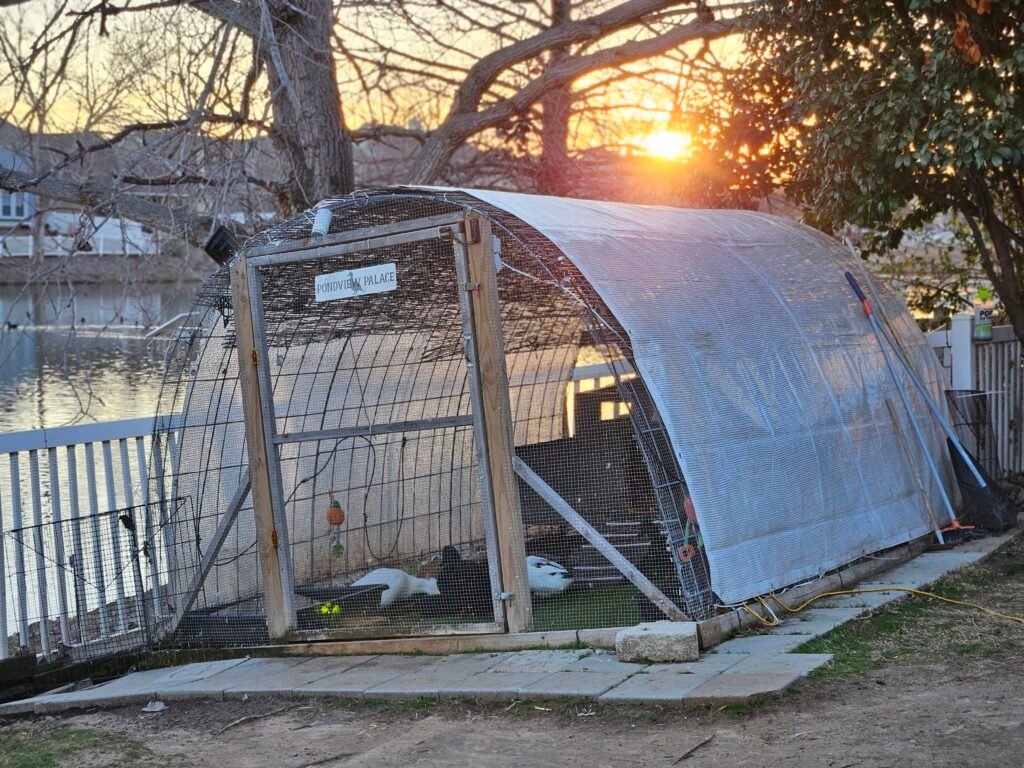
Snow and Ice Considerations
- In snowy climates, ducks still enjoy going outside, as long as they have a dry place to rest their feet.
- Lay down straw, pine shavings, or even plywood to give them a dry, non-slip path to walk on.
- Clear snow from high-traffic areas and make sure the coop and run entrances stay accessible.
➡️ Keeping Ducks in Winter – 7 Proven Tips
Bedding Materials and Cleaning Tips
Good bedding does more than just make your ducks comfortable—it plays a critical role in hygiene, warmth, odor control, and foot health. Ducks spend a lot of time on the ground, especially inside the coop at night, so a dry, cushioned, and absorbent surface is essential.
We’ve tested several types of bedding over the years, and while there’s no one-size-fits-all solution, some materials work far better than others for pet ducks.
Our Top Bedding Picks
- Pine shavings:
Our go-to. They’re affordable, widely available, and excellent at absorbing moisture and controlling odor. We avoid fine or dusty shavings and opt for medium flakes, which are less likely to irritate eyes and nostrils. - Straw:
A common option that offers warmth and insulation, but it’s less absorbent and requires more frequent changes. It’s best layered over a base like shavings or dry soil. - Hay (sparingly):
Ducks love to nest in hay, but it molds quickly if it gets wet. We only use it in small amounts for nest boxes and rotate it often. - Artificial turf (in runs):
This is not for inside the coop, but it is worth mentioning that our premium pet turf in the run has been a game changer. It drains well, has a soft underfoot, and reduces mud and bumblefoot issues. - Rubber mats or vinyl flooring (as a base):
We installed vinyl flooring over our plywood coop floor to make cleaning easier and prevent moisture damage. It’s easy to sweep or hose down and protects the underlying structure.
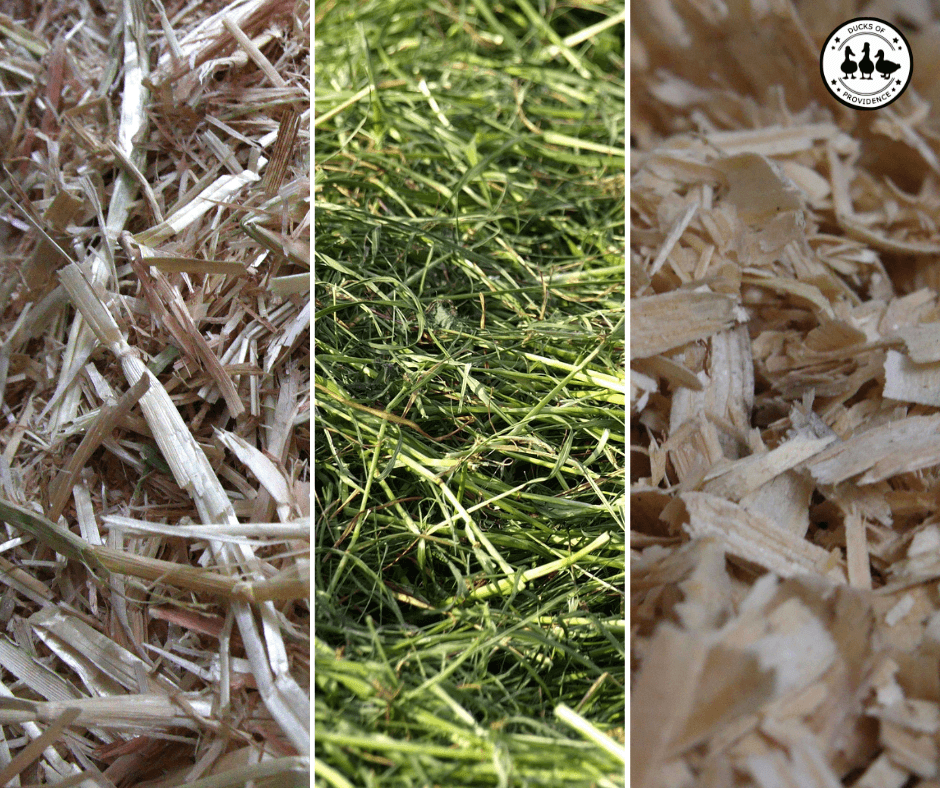
Bedding to Avoid
- Cedar shavings:
These are toxic to birds and can irritate ducks’ respiratory systems. Always avoid them. - Newspaper or glossy paper:
Slippery when wet and not absorbent. They increase the risk of leg injuries, especially in ducklings. - Sand (indoors):
While sand works well for some chicken keepers, it tends to hold moisture and can be heavy and cold underfoot for ducks.
➡️ What is the Best Bedding for Ducks?
Cleaning Routine
- Daily spot-cleaning:
Remove wet or soiled bedding around waterers and nest boxes to prevent mold and ammonia buildup. - Weekly deep clean:
Remove all bedding, scrub floors (especially if you don’t use vinyl or a removable liner), and replace with fresh, dry material. - Nest box checks:
If your ducks lay in the coop, keep nesting areas clean and cushioned to reduce the risk of egg breakage or dirty shells.
We clean our coop once a week and do small daily touch-ups in high-traffic spots. Having hinged roof access on our nesting areas has made this much easier!
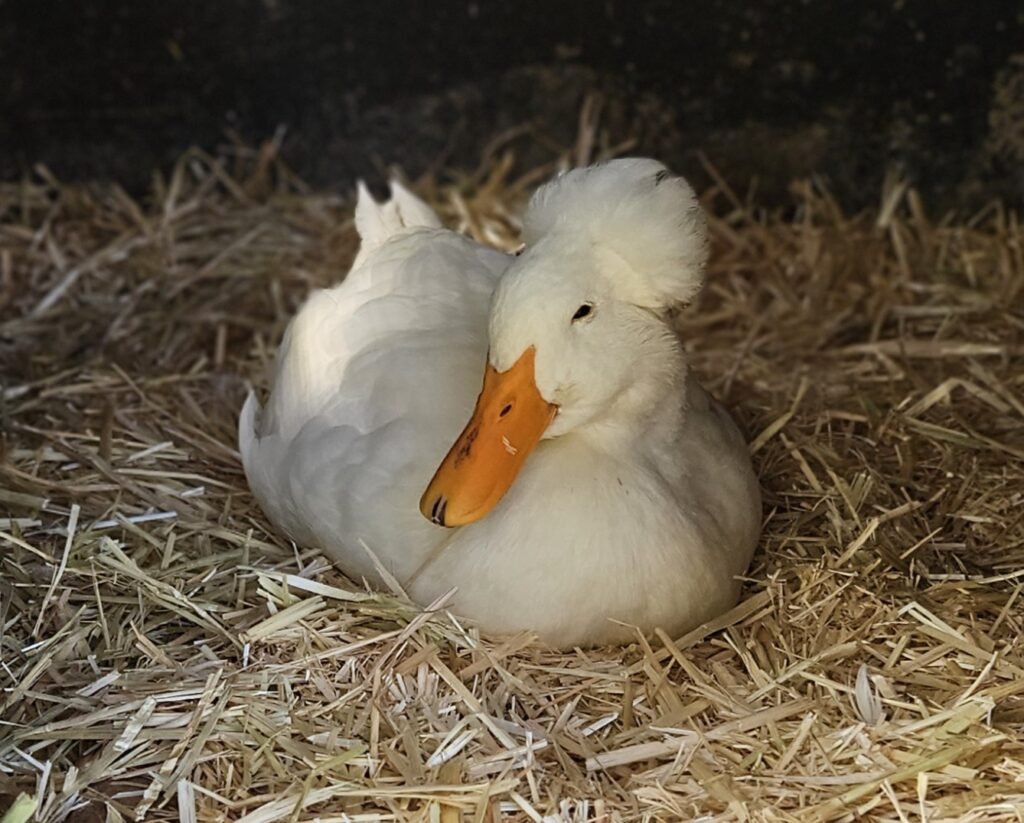
Seasonal Adjustments
- In colder months, you can use the deep litter method, layering clean bedding over old to build insulation and generate heat. Just be sure to monitor moisture levels to avoid mold or ammonia.
- In summer, lighter bedding and good ventilation are more important than insulation. Remove damp material promptly to prevent flies and odor.
Final Thoughts
Designing a safe, comfortable, and enriching home for your ducks is one of the most rewarding parts of being a duck keeper. Whether you’re just starting out or improving an existing setup, every detail—from the flooring under their feet to the shade over their heads—matters.
A well-built coop keeps them safe at night. A secure run or aviary lets them enjoy the outdoors without fear. And thoughtful touches like clean water, healthy feed, soft bedding, and enrichment activities turn a basic shelter into a space where ducks can truly thrive.
Over the years with our own flock, we’ve learned that there’s no one-size-fits-all setup. What matters most is finding a solution that works for your space, your climate, and your ducks’ personalities. Start with the essentials—security, cleanliness, and access to water—and build from there.
Most of all, remember that ducks are highly social, intelligent animals who rely on us for everything. When we create an environment that lets them forage, splash, nap, and explore safely, they reward us with affection, curiosity, and joy beyond measure.
If you’re ever unsure where to begin, keep it simple: think like a duck. Would you feel safe, dry, and happy in that space? Would you be excited to go out and explore it each day? If the answer is yes, you’re already on the right path.
We’ve put together a curated Amazon shopping list filled with duck coop and run essentials—many of which we personally use for our own flock. From predator-proofing tools to practical cleaning supplies and cozy bedding options, this list includes tried-and-true products that help us keep our ducks safe, clean, and comfortable. Whether you’re building your setup from scratch or just looking to upgrade a few items, we’ve gathered everything in one place to make it easier for you.
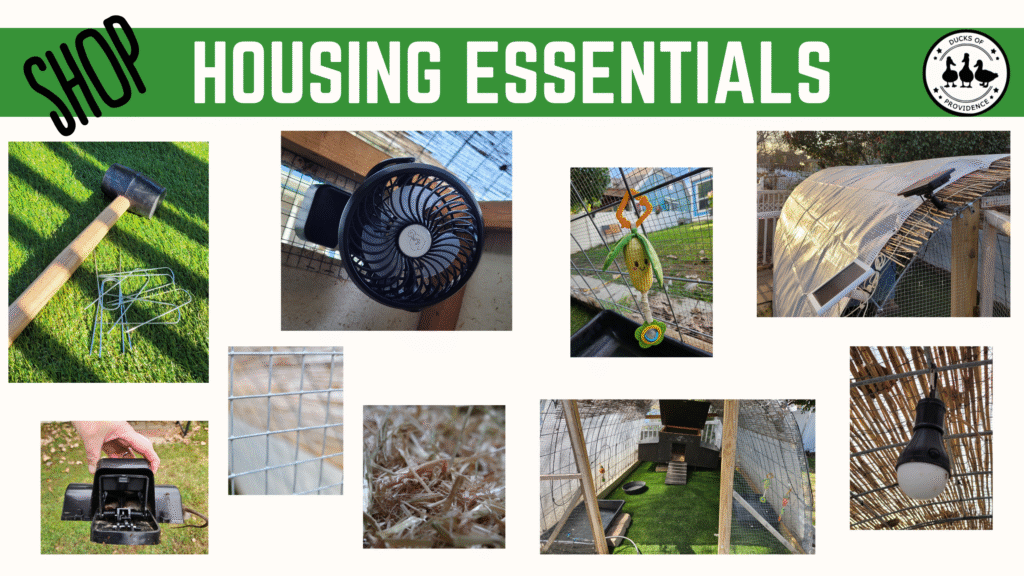
Related Articles
➡️ 17 Duck Predators – Common And Not-So-Common Ones
➡️ How to keep your ducks safe from predators?
➡️ Rodent Control in the Duck Run: Safe and Effective Strategies for Duck Keepers
➡️ Ducks and Water: Keeping Your Flock Happy and Healthy
➡️ Feeding Ducks: A Guide to Keeping Your Flock Happy and Healthy
➡️ Keeping Ducks Cool During the Hottest Months – Effective Tips to Beat the Heat
➡️ How Artificial Turf Transformed Our Duck Run
➡️ What is the Best Bedding for Ducks?



